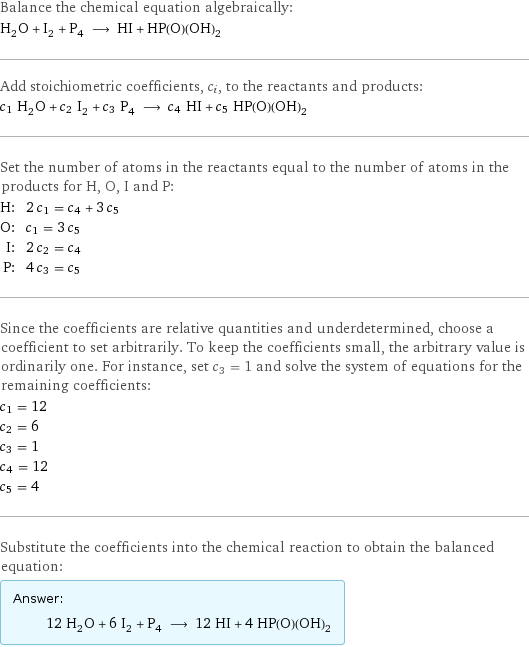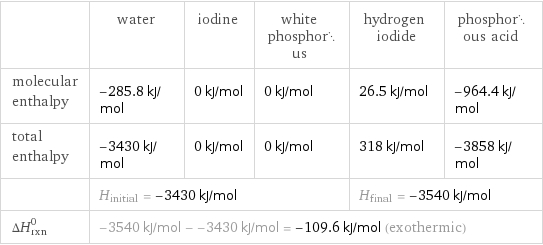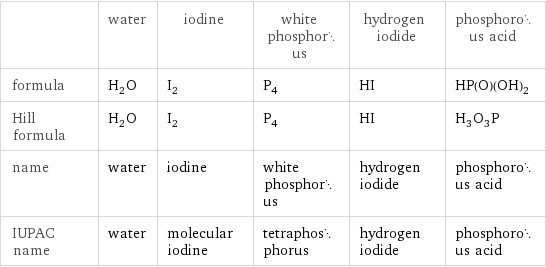Input interpretation

H_2O (water) + I_2 (iodine) + P_4 (white phosphorus) ⟶ HI (hydrogen iodide) + HP(O)(OH)_2 (phosphorous acid)
Balanced equation

Balance the chemical equation algebraically: H_2O + I_2 + P_4 ⟶ HI + HP(O)(OH)_2 Add stoichiometric coefficients, c_i, to the reactants and products: c_1 H_2O + c_2 I_2 + c_3 P_4 ⟶ c_4 HI + c_5 HP(O)(OH)_2 Set the number of atoms in the reactants equal to the number of atoms in the products for H, O, I and P: H: | 2 c_1 = c_4 + 3 c_5 O: | c_1 = 3 c_5 I: | 2 c_2 = c_4 P: | 4 c_3 = c_5 Since the coefficients are relative quantities and underdetermined, choose a coefficient to set arbitrarily. To keep the coefficients small, the arbitrary value is ordinarily one. For instance, set c_3 = 1 and solve the system of equations for the remaining coefficients: c_1 = 12 c_2 = 6 c_3 = 1 c_4 = 12 c_5 = 4 Substitute the coefficients into the chemical reaction to obtain the balanced equation: Answer: | | 12 H_2O + 6 I_2 + P_4 ⟶ 12 HI + 4 HP(O)(OH)_2
Structures

+ + ⟶ +
Names

water + iodine + white phosphorus ⟶ hydrogen iodide + phosphorous acid
Reaction thermodynamics
Enthalpy

| water | iodine | white phosphorus | hydrogen iodide | phosphorous acid molecular enthalpy | -285.8 kJ/mol | 0 kJ/mol | 0 kJ/mol | 26.5 kJ/mol | -964.4 kJ/mol total enthalpy | -3430 kJ/mol | 0 kJ/mol | 0 kJ/mol | 318 kJ/mol | -3858 kJ/mol | H_initial = -3430 kJ/mol | | | H_final = -3540 kJ/mol | ΔH_rxn^0 | -3540 kJ/mol - -3430 kJ/mol = -109.6 kJ/mol (exothermic) | | | |
Equilibrium constant
![Construct the equilibrium constant, K, expression for: H_2O + I_2 + P_4 ⟶ HI + HP(O)(OH)_2 Plan: • Balance the chemical equation. • Determine the stoichiometric numbers. • Assemble the activity expression for each chemical species. • Use the activity expressions to build the equilibrium constant expression. Write the balanced chemical equation: 12 H_2O + 6 I_2 + P_4 ⟶ 12 HI + 4 HP(O)(OH)_2 Assign stoichiometric numbers, ν_i, using the stoichiometric coefficients, c_i, from the balanced chemical equation in the following manner: ν_i = -c_i for reactants and ν_i = c_i for products: chemical species | c_i | ν_i H_2O | 12 | -12 I_2 | 6 | -6 P_4 | 1 | -1 HI | 12 | 12 HP(O)(OH)_2 | 4 | 4 Assemble the activity expressions accounting for the state of matter and ν_i: chemical species | c_i | ν_i | activity expression H_2O | 12 | -12 | ([H2O])^(-12) I_2 | 6 | -6 | ([I2])^(-6) P_4 | 1 | -1 | ([P4])^(-1) HI | 12 | 12 | ([HI])^12 HP(O)(OH)_2 | 4 | 4 | ([HP(O)(OH)2])^4 The equilibrium constant symbol in the concentration basis is: K_c Mulitply the activity expressions to arrive at the K_c expression: Answer: | | K_c = ([H2O])^(-12) ([I2])^(-6) ([P4])^(-1) ([HI])^12 ([HP(O)(OH)2])^4 = (([HI])^12 ([HP(O)(OH)2])^4)/(([H2O])^12 ([I2])^6 [P4])](../image_source/dabe782f527b05c8c5a7e908fd7d4189.png)
Construct the equilibrium constant, K, expression for: H_2O + I_2 + P_4 ⟶ HI + HP(O)(OH)_2 Plan: • Balance the chemical equation. • Determine the stoichiometric numbers. • Assemble the activity expression for each chemical species. • Use the activity expressions to build the equilibrium constant expression. Write the balanced chemical equation: 12 H_2O + 6 I_2 + P_4 ⟶ 12 HI + 4 HP(O)(OH)_2 Assign stoichiometric numbers, ν_i, using the stoichiometric coefficients, c_i, from the balanced chemical equation in the following manner: ν_i = -c_i for reactants and ν_i = c_i for products: chemical species | c_i | ν_i H_2O | 12 | -12 I_2 | 6 | -6 P_4 | 1 | -1 HI | 12 | 12 HP(O)(OH)_2 | 4 | 4 Assemble the activity expressions accounting for the state of matter and ν_i: chemical species | c_i | ν_i | activity expression H_2O | 12 | -12 | ([H2O])^(-12) I_2 | 6 | -6 | ([I2])^(-6) P_4 | 1 | -1 | ([P4])^(-1) HI | 12 | 12 | ([HI])^12 HP(O)(OH)_2 | 4 | 4 | ([HP(O)(OH)2])^4 The equilibrium constant symbol in the concentration basis is: K_c Mulitply the activity expressions to arrive at the K_c expression: Answer: | | K_c = ([H2O])^(-12) ([I2])^(-6) ([P4])^(-1) ([HI])^12 ([HP(O)(OH)2])^4 = (([HI])^12 ([HP(O)(OH)2])^4)/(([H2O])^12 ([I2])^6 [P4])
Rate of reaction
![Construct the rate of reaction expression for: H_2O + I_2 + P_4 ⟶ HI + HP(O)(OH)_2 Plan: • Balance the chemical equation. • Determine the stoichiometric numbers. • Assemble the rate term for each chemical species. • Write the rate of reaction expression. Write the balanced chemical equation: 12 H_2O + 6 I_2 + P_4 ⟶ 12 HI + 4 HP(O)(OH)_2 Assign stoichiometric numbers, ν_i, using the stoichiometric coefficients, c_i, from the balanced chemical equation in the following manner: ν_i = -c_i for reactants and ν_i = c_i for products: chemical species | c_i | ν_i H_2O | 12 | -12 I_2 | 6 | -6 P_4 | 1 | -1 HI | 12 | 12 HP(O)(OH)_2 | 4 | 4 The rate term for each chemical species, B_i, is 1/ν_i(Δ[B_i])/(Δt) where [B_i] is the amount concentration and t is time: chemical species | c_i | ν_i | rate term H_2O | 12 | -12 | -1/12 (Δ[H2O])/(Δt) I_2 | 6 | -6 | -1/6 (Δ[I2])/(Δt) P_4 | 1 | -1 | -(Δ[P4])/(Δt) HI | 12 | 12 | 1/12 (Δ[HI])/(Δt) HP(O)(OH)_2 | 4 | 4 | 1/4 (Δ[HP(O)(OH)2])/(Δt) (for infinitesimal rate of change, replace Δ with d) Set the rate terms equal to each other to arrive at the rate expression: Answer: | | rate = -1/12 (Δ[H2O])/(Δt) = -1/6 (Δ[I2])/(Δt) = -(Δ[P4])/(Δt) = 1/12 (Δ[HI])/(Δt) = 1/4 (Δ[HP(O)(OH)2])/(Δt) (assuming constant volume and no accumulation of intermediates or side products)](../image_source/e98a62a971d383db52f75654b6318d38.png)
Construct the rate of reaction expression for: H_2O + I_2 + P_4 ⟶ HI + HP(O)(OH)_2 Plan: • Balance the chemical equation. • Determine the stoichiometric numbers. • Assemble the rate term for each chemical species. • Write the rate of reaction expression. Write the balanced chemical equation: 12 H_2O + 6 I_2 + P_4 ⟶ 12 HI + 4 HP(O)(OH)_2 Assign stoichiometric numbers, ν_i, using the stoichiometric coefficients, c_i, from the balanced chemical equation in the following manner: ν_i = -c_i for reactants and ν_i = c_i for products: chemical species | c_i | ν_i H_2O | 12 | -12 I_2 | 6 | -6 P_4 | 1 | -1 HI | 12 | 12 HP(O)(OH)_2 | 4 | 4 The rate term for each chemical species, B_i, is 1/ν_i(Δ[B_i])/(Δt) where [B_i] is the amount concentration and t is time: chemical species | c_i | ν_i | rate term H_2O | 12 | -12 | -1/12 (Δ[H2O])/(Δt) I_2 | 6 | -6 | -1/6 (Δ[I2])/(Δt) P_4 | 1 | -1 | -(Δ[P4])/(Δt) HI | 12 | 12 | 1/12 (Δ[HI])/(Δt) HP(O)(OH)_2 | 4 | 4 | 1/4 (Δ[HP(O)(OH)2])/(Δt) (for infinitesimal rate of change, replace Δ with d) Set the rate terms equal to each other to arrive at the rate expression: Answer: | | rate = -1/12 (Δ[H2O])/(Δt) = -1/6 (Δ[I2])/(Δt) = -(Δ[P4])/(Δt) = 1/12 (Δ[HI])/(Δt) = 1/4 (Δ[HP(O)(OH)2])/(Δt) (assuming constant volume and no accumulation of intermediates or side products)
Chemical names and formulas

| water | iodine | white phosphorus | hydrogen iodide | phosphorous acid formula | H_2O | I_2 | P_4 | HI | HP(O)(OH)_2 Hill formula | H_2O | I_2 | P_4 | HI | H_3O_3P name | water | iodine | white phosphorus | hydrogen iodide | phosphorous acid IUPAC name | water | molecular iodine | tetraphosphorus | hydrogen iodide | phosphorous acid